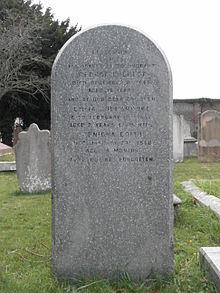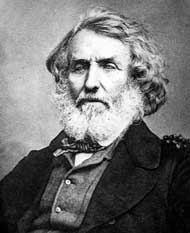George Everest
Sir George Everest [ ˈiːvrɨst ], (born July 4, 1790 in Crickhowell , Powys , Wales , † December 1, 1866 in London ) was a British geodesist and officer. For many years he was the head of the Great Trigonometric Survey of India and Surveyor General of India . After him was Mount Everest named.
Live and act
George Everest was born on July 4, 1790 at Gwernvale Manor, northwest of Crickhowell, Welsh. After schooling at the Junior Department of the Royal Military College in Great Marlow and at the Royal Military Academy Woolwich , he joined the East India Company as a cadet in 1806 and sailed to India in the same year . As part of his military service in Bengal , he was entrusted with various tasks, including the two-year survey of the island of Java , the improvement of navigation in the estuary of the Ganges Delta and the management of the construction of a telegraph line from Calcutta to Benares .
In 1817 Everest was appointed assistant to the Great Trigonometric Survey of India under Colonel William Lambton , who at the time was based in Hyderabad . Everest took up this position in 1818. While working in the unhealthy regions of the princely state of the Nizam of Hyderabad, however, he fell so ill in 1820 that he was sent to Cape Town to recover .

After Lambton's death on January 20, 1823, Everest was appointed his successor and continued surveying work in central India. In 1825, however, his health had deteriorated so much that he returned to England. In June 1830 he returned to India for considerably more extensive tasks, as he had also been appointed Surveyor-General of India in addition to heading the Great Trigonometric Survey.
In 1832 he resumed the Indian meridian measurement ( The Great Arc ), which was also started by Lambton and extended over more than 21 ° from the southern tip of India to the foothills of the Himalayas north of Dehradun . To do this, he moved his quarters to a house he had built near Mussorie . His request to move the headquarters of the Survey of India there was not granted, but as a compromise the agency was relocated to Dehradun, where it has been based ever since. In 1841 he completed the work on the Great Arc.
Two years later, Everest quit his service in India and returned to England to serve as a member of the Royal Society in the following years .
George Everest is the great-uncle of the British mathematician Alicia Boole Stott .
Services
George Everest devoted himself for twenty-five years to the continuation of the Great Trigonometric Measurement and the completion of the Meridian Degree Measurement ( The Great Arc ) with great energy, tireless perseverance and the highest degree of accuracy , one of the greatest scientific projects of that time , despite some life-threatening illnesses . During this time he also carried out general surveying of India as Surveyor General for thirteen years.
He realized that the geodetic survey of the subcontinent with a comprehensive network was not possible within a manageable period of time and therefore switched it to the iron grid called gridiron , in which only triangular series were measured along the lines of longitude and latitude, while the gaps were then measured simpler topographical surveys of other departments of the Survey of India were completed, which could largely be made with the help of measuring tables . This grid system, in a modernized form, serves the Survey of India as the basis of its work to this day.
He introduced the compensation bars, invented by Colonel Colby , in order to be able to measure the length of baselines with the greatest possible precision and independently of the thermal expansion of the bars. He overcame the difficult visibility in the hazy Gangestal by developing mirror-reinforced oil lamps as trigonometric points on specially constructed surveying towers, the lamp holders of which were structurally separated from the observation platforms.
Honors
George Everest became a member of the Royal Society (FRS - Fellow of the Royal Society) (March 8, 1827), a member of the Asiatic Society of Bengal in Calcutta and a member (Fellow) of the Royal Astronomical Society , the Royal Asiatic Society of Great Britain and Ireland and the Royal Geographical Society .
Andrew Scott Waugh , his successor as Head of the Grand Trigonometric Surveyor and as Surveyor General of India, wrote to his deputy Waugh in Calcutta in 1856: “From ... Colonel George Everest I learned that every geographic object should be given the name that it gives to it Local people have given. ... But we couldn't find a name for this mountain. … In the eternal memory of the… master of precise geographic research, I propose… to call him 'Mount Everest'. "
In a letter to the Royal Geographical Society dated March 1, 1856, he announced that, according to his investigations, the summit, previously known internally as Peak XV , at 29,002 feet (8,840 m) above sea level, the highest peak in the Himalayas and thus probably in the world and he named it Mount Everest in honor of his predecessor .
At the Society's meeting on May 11, 1857, Everest showed himself to be honored and only raised objections because the Indian population could not pronounce his name. The meeting took positive note of Waugh's letter.
In 1861 Everest was named Companion of the Order of the Bath ( CB ) and was knighted as a Knight Bachelor .
Fonts
- An Account of the Measurement of the Arc of the Meridian between the parallels of 18 ° 3 'and 24 ° 7', being a continuation of the Grand Meridional Arc of India as detailed by the late Lieut.-Col. Lambton in the volumes of the Asiatic Society of Calcutta . London, 1830
- An Account of the Measurement of two Sections of the Meridional Arc of India, bounded by the parallels of 18 ° 3 '15' ', 24 ° 7' 11 '' and 29 ° 30 '48' 'Conducted under the Orders of the Honorable East India Company . London, 1847
literature
- John Keay: The Great Arc - The Dramatic Tale of How India Was Mapped and Everest Was Named. Harper Perennial, New York 2001, ISBN 0-06-093295-3 .
- Oliver Schulz: India on foot - A journey on the 78th degree of longitude. Deutsche Verlags-Anstalt, Munich 2011, ISBN 978-3-421-04474-7 .
Web links
- Irene Meichsner: 150 years ago - the death of surveyor George Everest . Deutschlandfunk broadcast “Calendar Sheet”, December 1, 2016.
Individual evidence
- ^ Claypole, Jonty (Director); Kunzru, Hari (presenter). (2003). Mapping Everest [TV Documentary]. BBC Television.
- ^ Biographical treatise by George Clement Boase: Everest, George in the Dictionary of National Biography
- ↑ The Gwernvale Manor , Brecon Road, Crickhowell, Powys NP8 1SE ( 51 ° 52 '7.2 " N , 3 ° 8' 50.2 ' W ), a listed property since July 19, 1963 (Grade II Listed Building ) and has long served as a hotel ( The Manor )
- ^ A b Clements R. Markham: A Memoir on the Indian Surveys . (PDF; 60.6 MB) 2nd edition WH Allen & Co., London 1878. Digitized at archive.org
- ↑ The information on Everest's surveying activities are largely based on the work of Markham
- ↑ The house is located in Hathi Paon at an altitude of around 2000 m, about 5 kilometers by road northwest of Mussorie ( 30 ° 27 ′ 31.5 ″ N , 78 ° 1 ′ 22.8 ″ E ). It overlooks the Dehradun Valley and the Himalayan mountain range on the other side. Of course, Mount Everest, which is more than 900 km away, cannot be seen.
- ↑ Rama Deb Roy: The Great Trigonometrical Survey of India in a Historical Perspective ( Memento of the original from March 31, 2010 in the Internet Archive ) Info: The archive link was automatically inserted and not yet checked. Please check the original and archive link according to the instructions and then remove this notice. . Indian Journal of History of Science, 21 (1): 22-32 (1986). Retrieved September 3, 2012
- ^ R. Ramachandran: Survey Saga on Frontline, April 27, 2002. Retrieved September 3, 2012
- ↑ List of Fellows of the Royal Society (PDF; 1.1 MB)
- ↑ Irene Meichsner: 150 years ago - death of the surveyor George Everest . Deutschlandfunk broadcast “Calendar Sheet”, December 1, 2016, accessed on December 1, 2016.
- ^ Proceedings of the Royal Geographical Society of London, no.IX, p. 345 Digitalisat on Google books
- ↑ George Everest has never seen the mountain named after him.
- ↑ George Clement Boase: Everest, George
| personal data | |
|---|---|
| SURNAME | Everest, George |
| BRIEF DESCRIPTION | British geodesist and officer |
| DATE OF BIRTH | 4th July 1790 |
| PLACE OF BIRTH | Crickhowell , Powys , Wales |
| DATE OF DEATH | December 1, 1866 |
| Place of death | London |
